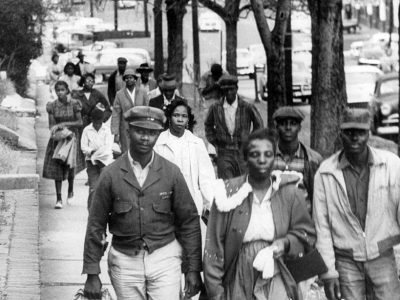The Montgomery Bus Boycott, which lasted from 5 December 1955 to 20 December 1956, was a pivotal event in the American Civil Rights Movement. It was a mass protest against the racially segregated bus system in Montgomery, Alabama, which the US Supreme Court declared unconstitutional. This 381-day boycott brought the issue of racial segregation in public transportation to the forefront of national attention. It also marked the emergence of Reverend Martin Luther King Jr. as a prominent leader in the fight for civil rights.
The catalyst: Rosa Parks’ arrest
On 1 December 1955, African American seamstress Rosa Parks was arrested after refusing to give up her seat on a city bus to a white passenger. This act of defiance directly responded to Montgomery’s city ordinance that required African American passengers to sit in the back half of buses and yield their seats to white riders if the front half, reserved for whites, was full.
Rosa Parks’ arrest sparked outrage among the African American community in Montgomery and served as the catalyst for the boycott. Parks, who was already an active member of the local chapter of the National Association for the Advancement of Colored People (NAACP), became an enduring symbol of resistance against racial segregation.
The Role of Women’s Political Council and Jo Ann Robinson
The success of the Montgomery Bus Boycott can largely be attributed to the behind-the-scenes organising efforts of the Women’s Political Council (WPC), led by Jo Ann Robinson. The WPC was a group of African American women working for civil rights who had been advocating for improved conditions on the buses for a decade before the boycott began.
Following Rosa Parks’ arrest, the WPC began circulating flyers calling for a boycott of the city buses on 5 December, the day Parks would be tried in municipal court. The group’s president, Jo Ann Robinson, was crucial in mobilising the African American community to support the boycott.
Emergence of Martin Luther King Jr. as a leader
As the Montgomery Bus Boycott gained momentum, African American leaders came together to form the Montgomery Improvement Association (MIA) to support and sustain the boycott and the legal challenge against segregation laws. Martin Luther King Jr., a charismatic young pastor of the Dexter Avenue Baptist Church, was elected president of the MIA.
King’s powerful oratory skills and commitment to nonviolent resistance made him the ideal leader to rally the African American community in Montgomery. The boycott eventually catapulted him into the national spotlight as one of the most influential figures in the American Civil Rights Movement.
The demands and the response
Initially, the MIA’s demands did not include changing segregation laws. Instead, they called for courtesy towards African American passengers, hiring Black bus drivers on predominantly African American routes, and a first-come, first-seated policy with whites entering and filling seats from the front and African Americans from the rear.
Despite the fact that African Americans constituted at least 75 per cent of Montgomery’s bus ridership, the city resisted meeting these demands. As the boycott continued, a group of five Montgomery women, represented by attorney Fred D. Gray and the NAACP, sued the city in US District Court, seeking to have the busing segregation laws completely invalidated.
The power of unity and organisation
The Montgomery Bus Boycott was successful due to the unity and organisation of the African American community. Black leaders organised carpools to help people get to work or other destinations, while African American taxi drivers charged only 10 cents for rides, the same price as bus fare.
Many African American residents chose to walk instead of using any form of transportation. Black leaders organised regular mass meetings to keep the community engaged and committed to the boycott.
Legal victory: Segregation laws declared unconstitutional
On 5 June 1956, a Montgomery federal court ruled that any law requiring racially segregated seating on buses violated the 14th Amendment to the US Constitution, which guarantees all citizens equal rights and equal protection under state and federal laws. The city appealed to the US Supreme Court, which upheld the lower court’s decision on 20 December 1956.
Montgomery’s buses were integrated on 21 December 1956, marking the end of the 381-day boycott.
The aftermath: Integration and violence
The integration of Montgomery’s buses was met with significant resistance and violence. Segregated bus stops were maintained, and snipers fired into buses, injuring passengers. In January 1957, several bombings targeted Black churches and the homes of prominent Black leaders, including Martin Luther King Jr.’s residence.
The police arrested seven members of the Ku Klux Klan, a white supremacist group, in connection to the bombings. This led to a decrease in busing-related violence.
The legacy of the Montgomery Bus Boycott
The Montgomery Bus Boycott marked the beginning of large-scale, nonviolent protests against racial segregation in the United States. It served as a model for future civil rights demonstrations and played a crucial role in inspiring other African American communities in the South to protest against racial discrimination.
The boycott also brought national and international attention to the civil rights struggles happening in the United States, with more than 100 reporters visiting Montgomery to document the events and their leaders.
The impact of Martin Luther King Jr. and Rosa Parks
The Montgomery Bus Boycott propelled Martin Luther King Jr. to the forefront of the American Civil Rights Movement. In the following years, King helped found the Southern Christian Leadership Conference (SCLC) and led numerous civil rights campaigns, including the Birmingham campaign and the March on Washington, where he delivered his famous “I Have a Dream” speech.
Rosa Parks, although often avoiding the spotlight, remained an esteemed figure in the history of American civil rights activism. In 1999, the US Congress awarded her the Congressional Gold Medal, its highest honour.
The Montgomery Bus Boycott marked a turning point in the American Civil Rights Movement, setting the stage for future mass protests against racial discrimination and solidifying the importance of nonviolent resistance. The boycott’s success demonstrated the power of unity and organisation within the African American community, and the impact of its leaders, such as Martin Luther King Jr. and Rosa Parks, continues to inspire the fight for equality and justice to this day.





